Cave Spring Farm—Working in the Morning
Cave Spring Farm is located in Owen County, on Indian Creek north of Gosport. The Farm history starts with William Asher (1740-1780) enlisting as a private soldier in the Virginia State Line militia in Virginia. William Asher served under General George Rogers Clark including the Illinois expedition 1778-1780. Ensign William Asher was ambushed and killed by Indians in June 1780 near Ft Louisville and was buried where he fell south of the Falls of the Ohio. William Asher’s teenage son, Bartlett Asher (1764-1841) became a military orphan on that day. As result of his father’s military service to the country on the Illinois Campaign, Asher was subsequently granted land in Indiana (1788) and Illinois (1832). 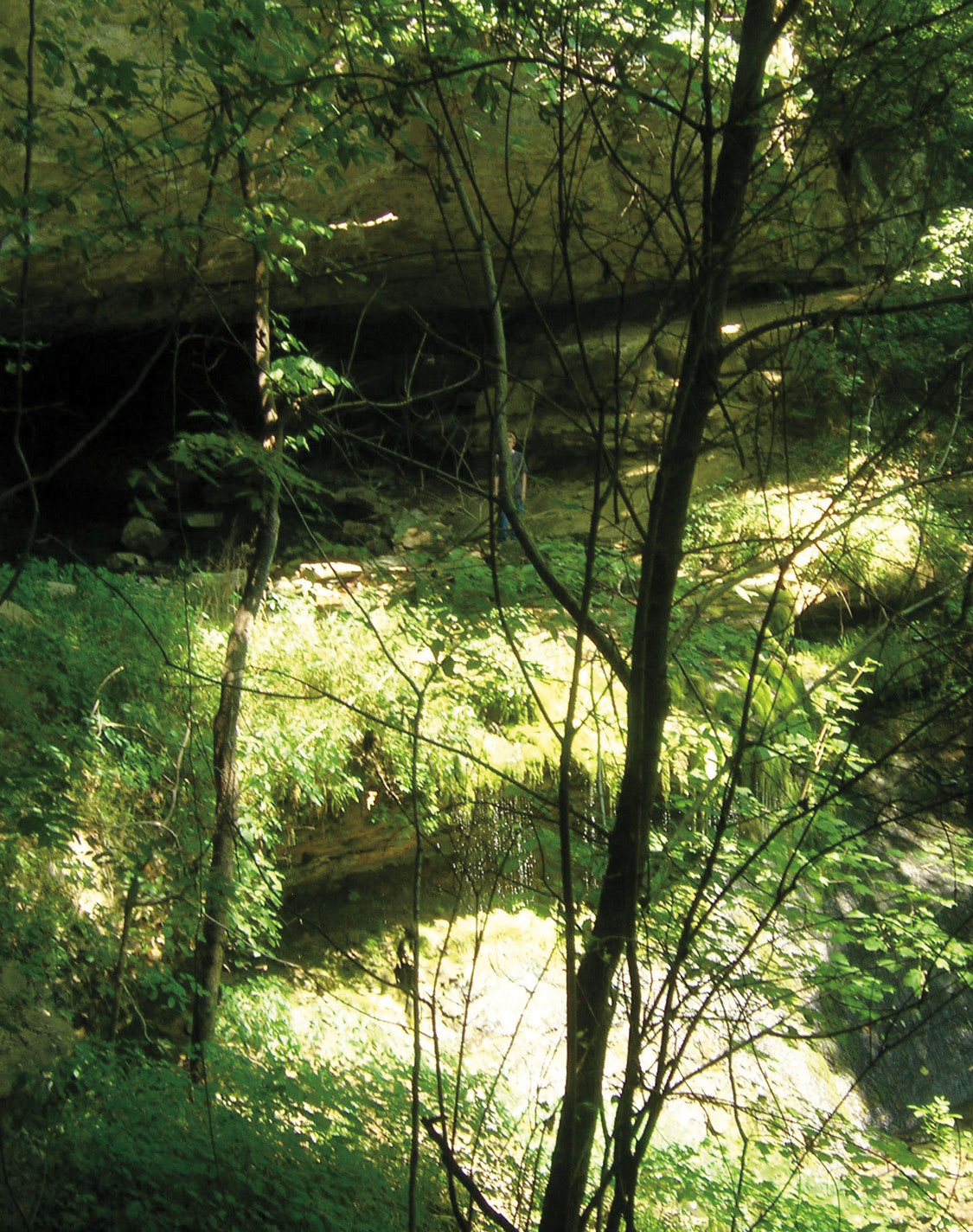 Spring Cave waterfall and Indian Creek Headwater. Note: man in the cave is obscured by the tree.The Indiana land grant was the nexus for 8 generations of family forestland ownership in Indiana. Bartlett is buried on his farm, marked by a 20thcentury tombstone placed by the Daughters of the American Revolution, in the woods north of Gosport. Bartlett’s son William Asher (1792-1837), also served under territorial Governor and future president William Henry Harrison at Ft Louisville and passed Gosport on an expedition north following the Battle of Tippecanoe.
Spring Cave waterfall and Indian Creek Headwater. Note: man in the cave is obscured by the tree.The Indiana land grant was the nexus for 8 generations of family forestland ownership in Indiana. Bartlett is buried on his farm, marked by a 20thcentury tombstone placed by the Daughters of the American Revolution, in the woods north of Gosport. Bartlett’s son William Asher (1792-1837), also served under territorial Governor and future president William Henry Harrison at Ft Louisville and passed Gosport on an expedition north following the Battle of Tippecanoe.
At the head of Indian Creek north of Gosport is a spring cave now called Rogers Cave. Following military service William Asher returned to Gosport and operated a distillery and overshot water wheel flouring and lumber mill at the mouth of the Spring Cave starting in 1828. Corn liquor was hauled overland to Cincinnati or traded locally “a bushel of corn for a gallon of juice”. The mill produced nearly all the timber for local pioneer homes and buildings. The mill suffered low seasonal flow and was upgraded to steam power in 1850. The mill was abandoned in 1878 and left to decay. Industry moved to Gosport after the Louisville, New Albany and Chicago (later The Monon and now abandoned) railroad bypassed the mill in 1847. During the Victorian era, the train carried tourists from Gosport hotels to Cave Station, a train stop near the farm. Carriages shuttled tourists from Cave Station to Spring Cave box canyon for picnics. The box canyon and rugged cave area are now heavily wooded and hard to access. Cave station is long gone except on old maps. The mill, oxen road and the abandoned village of Middleton above the cave are difficult to imagine walking the woods today.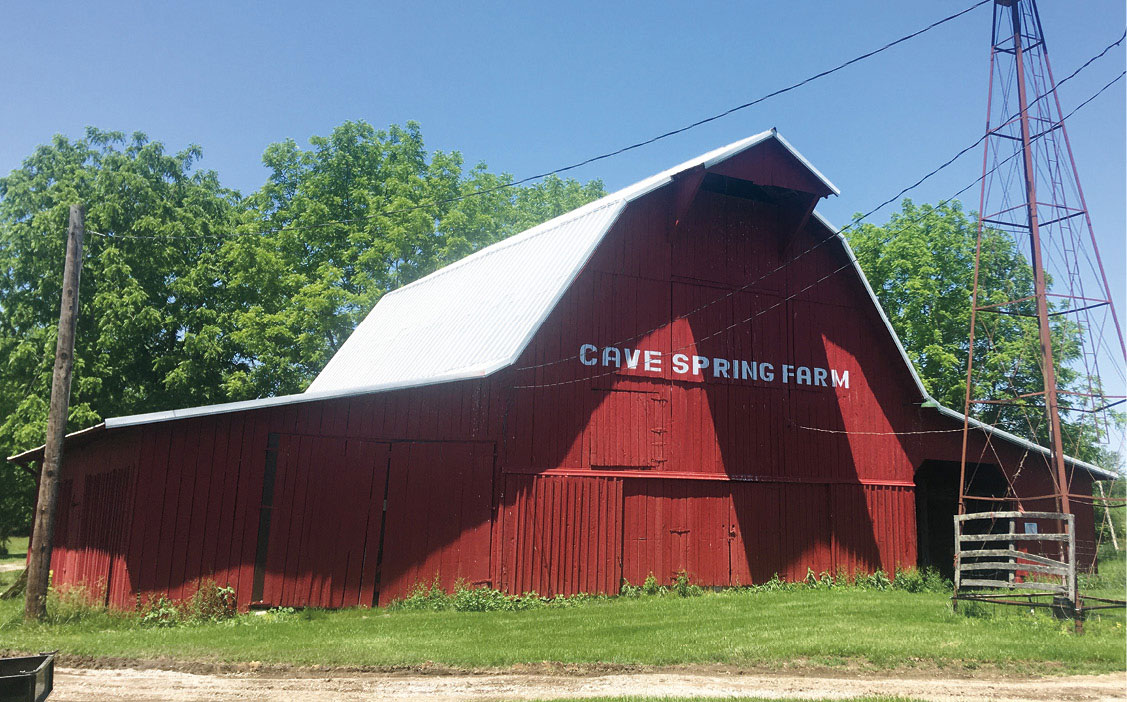 1934 Hoosier heritage dairy barn stabilized in 2010 with farm sawn heartwood poplar.
1934 Hoosier heritage dairy barn stabilized in 2010 with farm sawn heartwood poplar.
The spring flow today and varies seasonally. The cave floods during storms. In 2005, Dave Everton of Indiana University and the Central Indiana Grotto of the National Speleological Society requested access to the cave network. His team spent a summer mapping over 5 miles of wet crawlways. University of Illinois at Chicago also performed geological surveys in the cave and other nearby caves to research glaciation in Indiana. Carbon-14 dating verified woodland era fire pits used on an E-W Indian trace passing the cave.
My wife’s grandfather recovered the old millstone early in the 20th century using mules. He donated the stone to Purdue where it sat outside an agriculture building for decades. John William Asher, my father-in-law, is professor emeritus at Purdue living in West Lafayette. The stone now sits outside the Pioneer building at the Indiana State Fair grounds. While I was at Purdue that millstone was my introduction to the Asher family farm. I didn’t know the millstone’s significance at the time. Ruth Asher was an IU school of social work student home visiting her family for the summer in West Lafayette when we met. Several years later we married and started careers in Indianapolis. Ruth spent summers on the farm as a child in the 1960s and was taught how to “steal eggs” from her grandmother’s chickens, and “don’t make the cows run”. Our extended families cheer for IU and Purdue, but not always at the same time.
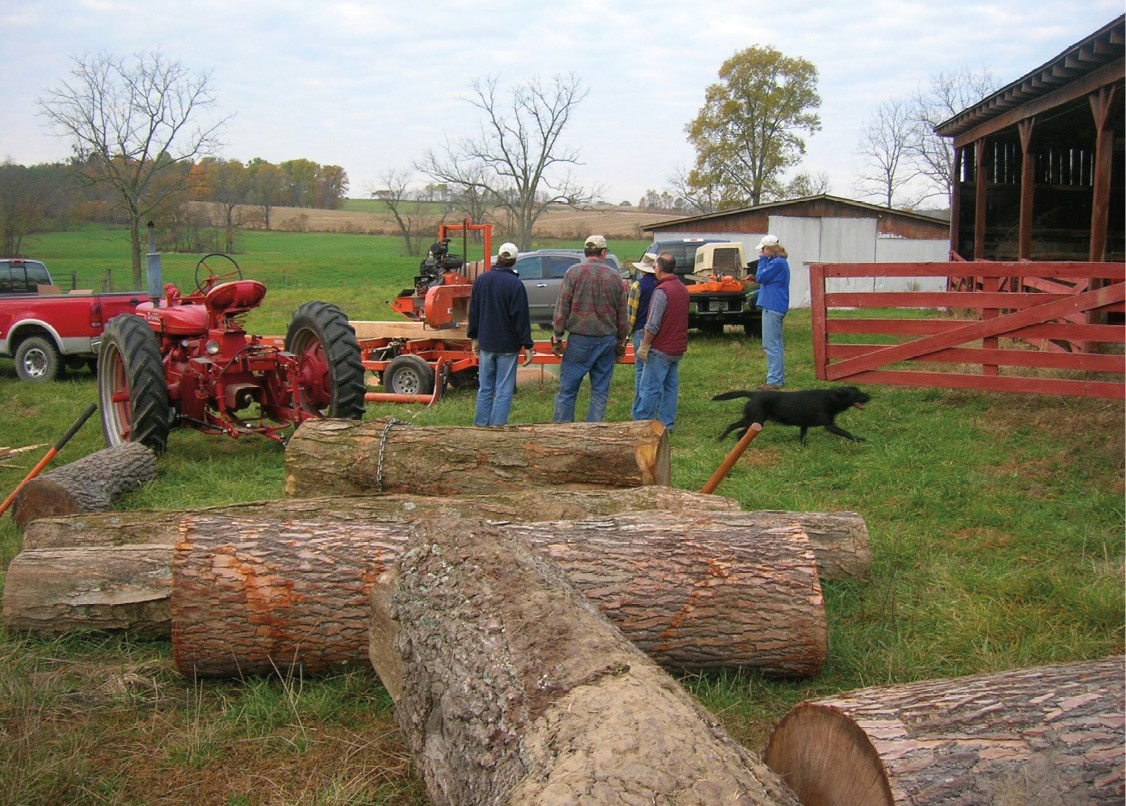 Woodmizer band mill salvaging mixed hardwoods after a fierce storm uprooted trees across, the township. Grandfather’s 1954 Farmall, abandoned 4 decades in a shed. Restored and skidding salvage logsDuring the late 20th century the farm was increasingly remotely managed. The small broken tillable fields and pastures were leased and are still leased today. Family cattle operations and pastures were abandoned. Barns and houses were sold or razed. Logging and sawmilling stopped. Beehives under the big blackgums collapsed.
Woodmizer band mill salvaging mixed hardwoods after a fierce storm uprooted trees across, the township. Grandfather’s 1954 Farmall, abandoned 4 decades in a shed. Restored and skidding salvage logsDuring the late 20th century the farm was increasingly remotely managed. The small broken tillable fields and pastures were leased and are still leased today. Family cattle operations and pastures were abandoned. Barns and houses were sold or razed. Logging and sawmilling stopped. Beehives under the big blackgums collapsed.
In 1992 I met Ruth’s great uncle, Paul Asher at the farm. Paul was 94 at that time and was the last Asher standing, who still worked the farm. He agreed to show me where to hunt ruffed grouse. The grouse were in a tangled overgrown thicket that I couldn’t penetrate let alone swing a shotgun. Paul was a retired IU dentist and commuted from Greenwood most mornings, early. Paul worked the farm until noon when it got too hot. He had an antique sawmill powered by a 1954 Farmall tractor leather belt take off. Stickered hardwood lumber was stacked in 3 barns. I restored and use the Farmall. Those barns, the mill and ruffed grouse are all gone. Paul cut black locust posts in a month ending in “uary’, when the sap is down. That morning Paul was hand digging a posthole along a ¼ mile fence, when I pulled up. I asked him: why a man your age was hand digging post holes? He stopped for a moment. Dan, Why does a young man your age play golf? He knew I liked golf. He was doing what he loved. Paul has been gone a while. Now I commute 3-4 days a week from Lawrence to kill invasive ailanthus, feed cattle, plant hardwoods and mend fence. I work in the morning, before it gets hot, like Paul did. 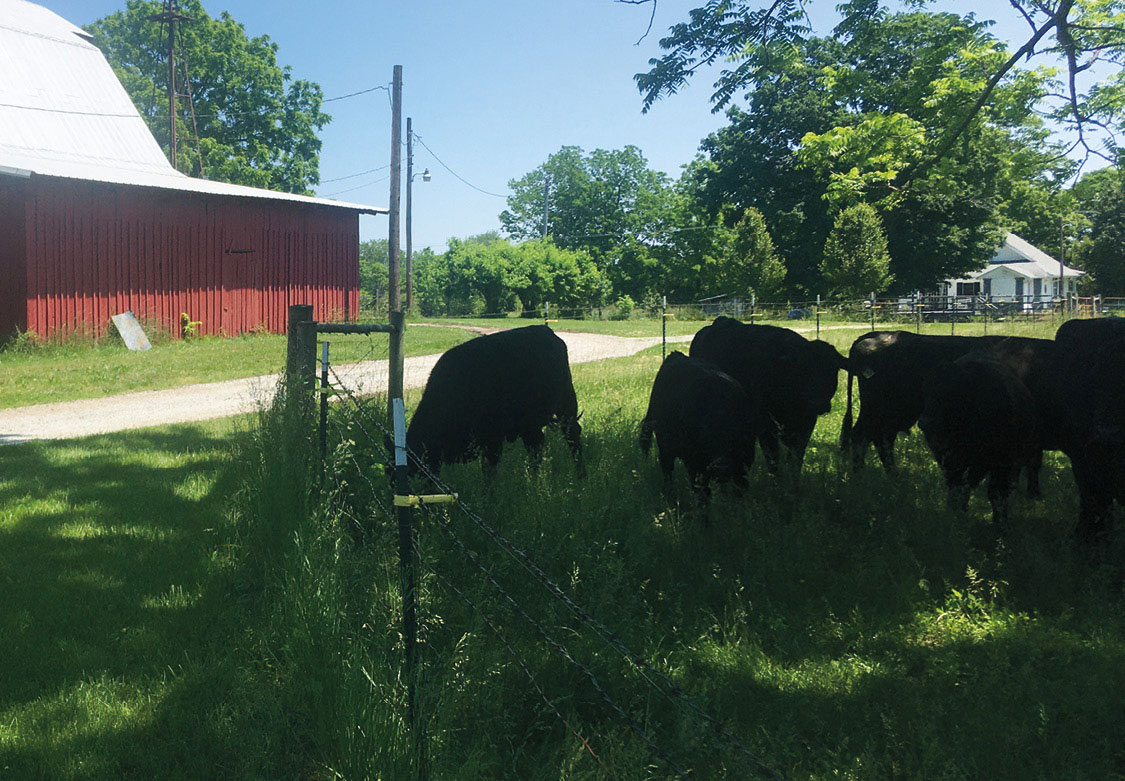 Grass fed, hormone free Angus cattle.
Grass fed, hormone free Angus cattle.
Cave Spring Farm is a Certified Tree Farm and all the eligible woodland is classified forest. The Ashers were early adopters of Indiana’s classified forest tax program. Some of it was mature forest, some young stands needing TSI or marginal pasture progressing back to woodland. Parcels were being sold. Starting in 2005 Ruth and I bought 3 parcels over a 10 yr period to maintain 400 contiguous acres around Spring Cave, a fraction of the original farm. Cave Spring Farm LLC was created for stewardship of the woodlands and preservation of tradition on Indian Creek. The tradition will pass to our sons.
We mill and barn dry saw logs on the farm periodically, totaling 10,000bf of mixed hardwood since 2006. Lumber sawn on farm has been used for barn restoration or gifted to family and friends who build furniture. We donate hardwood lumber to the Westminster Retirement Community shop.
I’ve restored a sinkhole filled pasture and raise grass fed hormone and antibiotic free beef. A young bull is back on pasture. We don’t charge you to cross the pasture, but the bull will! Our neighbors the Watsons farm our small broken fields, some intertwined with their fields. They patiently teach me farming, animal husbandry and weld up my broken equipment. I owe a huge debt to Watson Dairy.
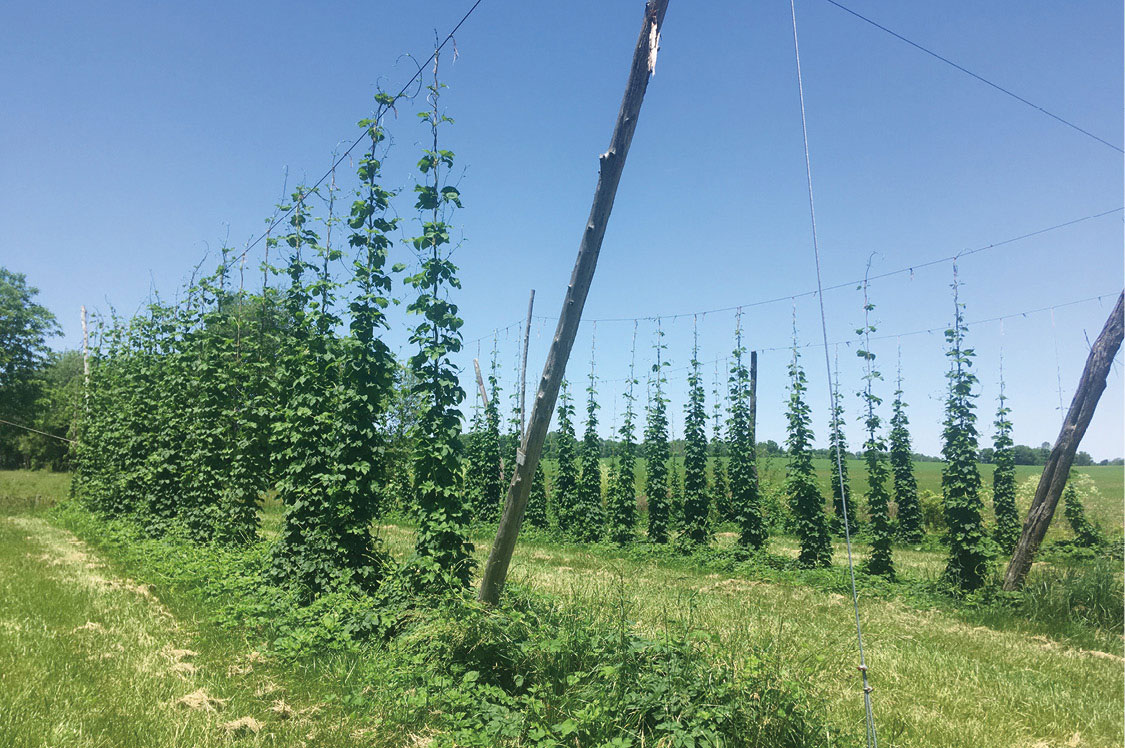 May 2021 hops yard with 6-year-old Chinook and Cascade bines supplying Blind Owl Brewery in Indianapolis with fresh local hops. Bines grow 17 ft. up new coir strings each spring.Following retirement in 2014, I became interested in locally supplied Indiana products. I started an experiment to supply locally grown hops to the Indiana microbrew industry after meeting with brewers. I joined the nascent Indiana Hops Growing Association and learned from the Purdue extension. I built a 1/8 acre, scalable pilot hop yard to test varieties from Michigan and adapted commercial techniques to the local limestone loam conditions. A hops bine (not vine) matures in 3 yrs. Two varieties worked, two failed. Crazy Horse Hops in Knightstown has invested $30 million in huge hops yard and a fantastic German engineered and supplied hops processing plant. They can support a new hops industry in the state. Water supply for hops irrigation expansion is scarce on the karst land at Cave Spring so I’ve decided not to scale up the 1/8 acre hop yard. Blind Owl Brewery in Indy purchases our fresh crop. If you visit the Blind Owl in the fall, try a pint of fresh hopped Cave Spring Farm Harvest Ale.
May 2021 hops yard with 6-year-old Chinook and Cascade bines supplying Blind Owl Brewery in Indianapolis with fresh local hops. Bines grow 17 ft. up new coir strings each spring.Following retirement in 2014, I became interested in locally supplied Indiana products. I started an experiment to supply locally grown hops to the Indiana microbrew industry after meeting with brewers. I joined the nascent Indiana Hops Growing Association and learned from the Purdue extension. I built a 1/8 acre, scalable pilot hop yard to test varieties from Michigan and adapted commercial techniques to the local limestone loam conditions. A hops bine (not vine) matures in 3 yrs. Two varieties worked, two failed. Crazy Horse Hops in Knightstown has invested $30 million in huge hops yard and a fantastic German engineered and supplied hops processing plant. They can support a new hops industry in the state. Water supply for hops irrigation expansion is scarce on the karst land at Cave Spring so I’ve decided not to scale up the 1/8 acre hop yard. Blind Owl Brewery in Indy purchases our fresh crop. If you visit the Blind Owl in the fall, try a pint of fresh hopped Cave Spring Farm Harvest Ale.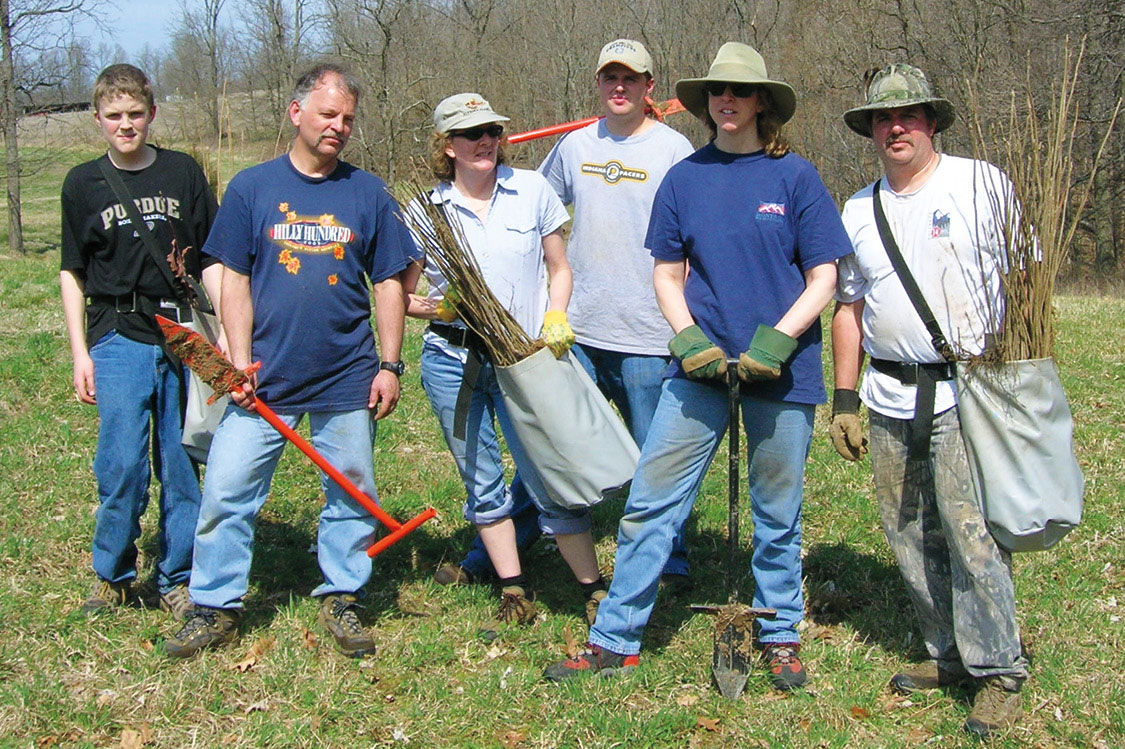 Three thousand seedlings hand planted over 15 years by family, friends and Stambaugh Forestry. The 2005 crew shown here planting white oak, walnut, spruce, and white pine pasture wind break.
Three thousand seedlings hand planted over 15 years by family, friends and Stambaugh Forestry. The 2005 crew shown here planting white oak, walnut, spruce, and white pine pasture wind break.
Ralph Unversaw, the Indiana district forester met with me soon after we acquired classified forest. He was a great help and recommended the Purdue Extension forest landowner class. Ralph also recommended contacting a consulting forester. I met John Stambaugh of Stambaugh Forestry in 2006. John’s Purdue forestry background and location next door in Greene County were a good fit. He has advised me on timber management and general Indiana landowner issues. John managed 2 small timber harvests over 10 years, one single tree selection and one sale largely of ash. The ash cut created 1 acre oak regeneration openings before the ash borer ravaged the township. He continues to advise me on herbicide use for invasive control and his company completed several conservation projects under the EQIP program. I value the long term consulting relationship. John recruited me into the Indiana Forestry and Woodland Owners Association.
